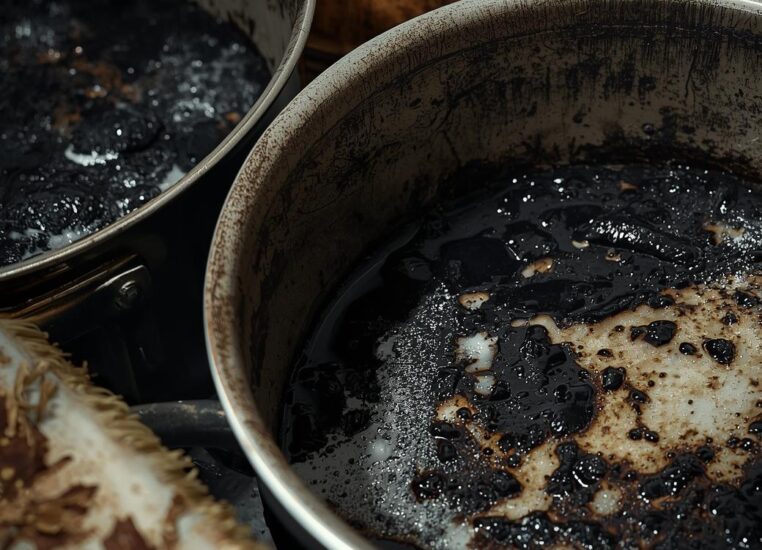Burnt pots and pans are one of the most frustrating kitchen mishaps.
Whether it’s a forgotten pot of rice, a sauce that bubbled over, or a pan left on high heat for too long, the aftermath can feel like a nightmare.
Blackened bottoms, stubborn crusts, and that lingering burnt smell can make even the most seasoned home cook want to give up.
But the good news is that with the right techniques, tools, and a little patience, those pots and pans can be restored to their former glory.
This guide dives deep into everything you need to know about cleaning burnt cookware.
From natural remedies to heavy-duty cleaning hacks, we’ll cover it all.
By the end, you’ll not only know how to rescue your cookware but also how to prevent future disasters.
Why Pots and Pans Burn in the First Place
Before jumping into cleaning methods, it helps to understand why pots and pans burn.
|
Cause |
Explanation |
Example |
|---|---|---|
|
High Heat |
Cooking on high heat without enough liquid or oil can scorch food quickly. |
Leaving pasta sauce on high heat until it sticks. |
|
Thin Cookware |
Cheap or thin pans don’t distribute heat evenly, causing hot spots. |
A thin aluminum pan burning rice in the center. |
|
Neglect |
Forgetting to stir or leaving food unattended leads to sticking and burning. |
Walking away from simmering oatmeal. |
|
Sugar Content |
Foods with sugar (like caramel or tomato sauce) burn faster. |
Caramel hardening and sticking to the pan. |
|
Oil Breakdown |
Overheating oil past its smoke point creates burnt residue. |
Frying with olive oil at very high heat. |

General Rules Before Cleaning
- Don’t scrape aggressively with metal utensils. This can damage nonstick coatings or scratch stainless steel.
- Let the pan cool before cleaning. Pouring cold water into a hot pan can warp it.
- Soak before scrubbing. A little patience goes a long way.
- Match the method to the material. Stainless steel, cast iron, and nonstick pans all need different care.
Quick Fixes for Light Burns
Sometimes the burn isn’t too bad—just a thin layer of stuck-on food. In these cases, a few simple tricks can save the day.
1. Boiling Water Method
- Fill the pan with water until the burnt area is covered.
- Bring it to a boil for 5–10 minutes.
- Use a wooden spoon or spatula to gently scrape off loosened bits.
This works best for pasta, rice, or sauces that left a thin burnt layer.
2. Baking Soda Paste
- Mix 3 tablespoons of baking soda with a little water to form a paste.
- Spread it over the burnt area.
- Let it sit for 30 minutes, then scrub with a sponge.
Baking soda is mildly abrasive and helps lift stains without scratching.
3. Salt Scrub
- Sprinkle coarse salt over the burnt area.
- Add a few drops of water to make a gritty paste.
- Scrub gently with a sponge or cloth.
Salt works well for stainless steel and enamel pans but should be avoided on nonstick surfaces.
Heavy-Duty Cleaning Methods
When the burn is stubborn and refuses to budge, it’s time to bring out stronger methods.
1. Vinegar and Baking Soda Combo
This classic duo works wonders.
Steps:
- Pour equal parts water and vinegar into the pan until the burnt area is covered.
- Bring to a boil for 5 minutes.
- Remove from heat and add 2 tablespoons of baking soda.
- Let it fizz, then scrub once cooled.
This method is especially effective for stainless steel.
2. Dish Soap and Dryer Sheet Hack
- Fill the pan with warm water and a few drops of dish soap.
- Add a dryer sheet and let it soak for an hour.
- Remove the sheet and scrub.
The chemicals in dryer sheets help loosen burnt residue.
3. Lemon and Salt Scrub
- Cut a lemon in half and dip it in coarse salt.
- Use it to scrub the burnt area.
- Rinse thoroughly.
This not only cleans but also removes odors.
4. Cream of Tartar Solution
- Mix 1 tablespoon of cream of tartar with 1 cup of water.
- Boil in the pan for 10 minutes.
- Let cool, then scrub.
Cream of tartar is acidic and works like vinegar but with less odor.
Cleaning by Cookware Type
Different materials require different care. Using the wrong method can ruin your cookware.
Stainless Steel
- Best methods: Vinegar + baking soda, boiling water, salt scrub.
- Avoid: Steel wool (can scratch).
Cast Iron
- Best methods: Boiling water, salt scrub, gentle scraping.
- Avoid: Soaking in water for long periods (causes rust).
- After cleaning: Always dry thoroughly and re-season with oil.
Nonstick
- Best methods: Baking soda paste, dish soap soak.
- Avoid: Abrasive scrubs, vinegar (can damage coating).
Copper
- Best methods: Lemon + salt, baking soda paste.
- Avoid: Harsh chemicals that strip the finish.
Enamel-Coated
- Best methods: Baking soda paste, vinegar soak.
- Avoid: Metal scrapers that chip the enamel.
Natural vs. Chemical Cleaners
|
Cleaner |
Type |
Best For |
Pros |
Cons |
|---|---|---|---|---|
|
Baking Soda |
Natural |
General burns |
Cheap, safe, non-toxic |
May need scrubbing effort |
|
Vinegar |
Natural |
Stainless steel, enamel |
Cuts grease, deodorizes |
Strong smell |
|
Lemon |
Natural |
Copper, odor removal |
Fresh scent, gentle |
Not as strong on heavy burns |
|
Dish Soap |
Chemical |
Nonstick, light burns |
Safe for coatings |
Not effective on heavy burns |
|
Commercial Cleaners |
Chemical |
Severe burns |
Fast, powerful |
Can be harsh, expensive |
Preventing Burnt Pots and Pans
The best way to deal with burnt cookware is to avoid it in the first place.
- Cook on medium heat. High heat is rarely necessary.
- Stir frequently. Especially with sauces, rice, or oatmeal.
- Use enough liquid. Dry cooking leads to scorching.
- Invest in quality cookware. Heavy-bottomed pans distribute heat better.
- Stay nearby. Walking away is the number one cause of burns.
Common Myths About Cleaning Burnt Pans
|
Myth |
Truth |
|---|---|
|
“Steel wool is the best for everything.” |
It scratches most cookware and should only be used on bare stainless steel. |
|
“Soaking overnight always works.” |
Sometimes soaking makes burnt food harder to remove. |
|
“Dishwasher fixes everything.” |
Dishwashers can damage nonstick and cast iron. |
|
“Burnt pans are ruined forever.” |
Most can be saved with the right method. |
Step-by-Step Rescue Plan for Severely Burnt Pans
- Assess the damage. Is it burnt food, burnt oil, or sugar?
- Choose the right method. Vinegar for stainless steel, salt for cast iron, baking soda for nonstick.
- Soak and loosen. Never attack it dry.
- Scrub gently. Use non-abrasive tools unless it’s stainless steel.
- Repeat if needed. Some burns take multiple rounds.
- Finish with polish. For stainless steel or copper, polish to restore shine.
Tools That Make Cleaning Easier
|
Tool |
Use |
|---|---|
|
Wooden Spoon |
Scraping without scratching |
|
Plastic Scraper |
Removing stuck bits on nonstick |
|
Non-scratch Sponge |
Everyday cleaning |
|
Steel Wool |
Only for stainless steel |
|
Microfiber Cloth |
Polishing and drying |
When to Replace a Pan
Sometimes, no matter how much scrubbing is done, a pan is beyond saving. Signs it’s time to replace:
- Nonstick coating is peeling.
- Cast iron has deep rust pits.
- Stainless steel is warped.
- Enamel is chipped and exposing metal.
Final Thoughts
Cleaning burnt pots and pans doesn’t have to be a dreaded chore.
With the right approach, even the most stubborn burns can be tackled.
From natural remedies like baking soda and lemon to heavy-duty methods with vinegar or commercial cleaners, there’s always a solution.
The key is patience, choosing the right method for the cookware type, and preventing burns in the first place.
Cooking mishaps happen to everyone, but with these tips, burnt pans won’t mean ruined cookware.
Instead, they’ll just be another small bump in the road to delicious meals.










